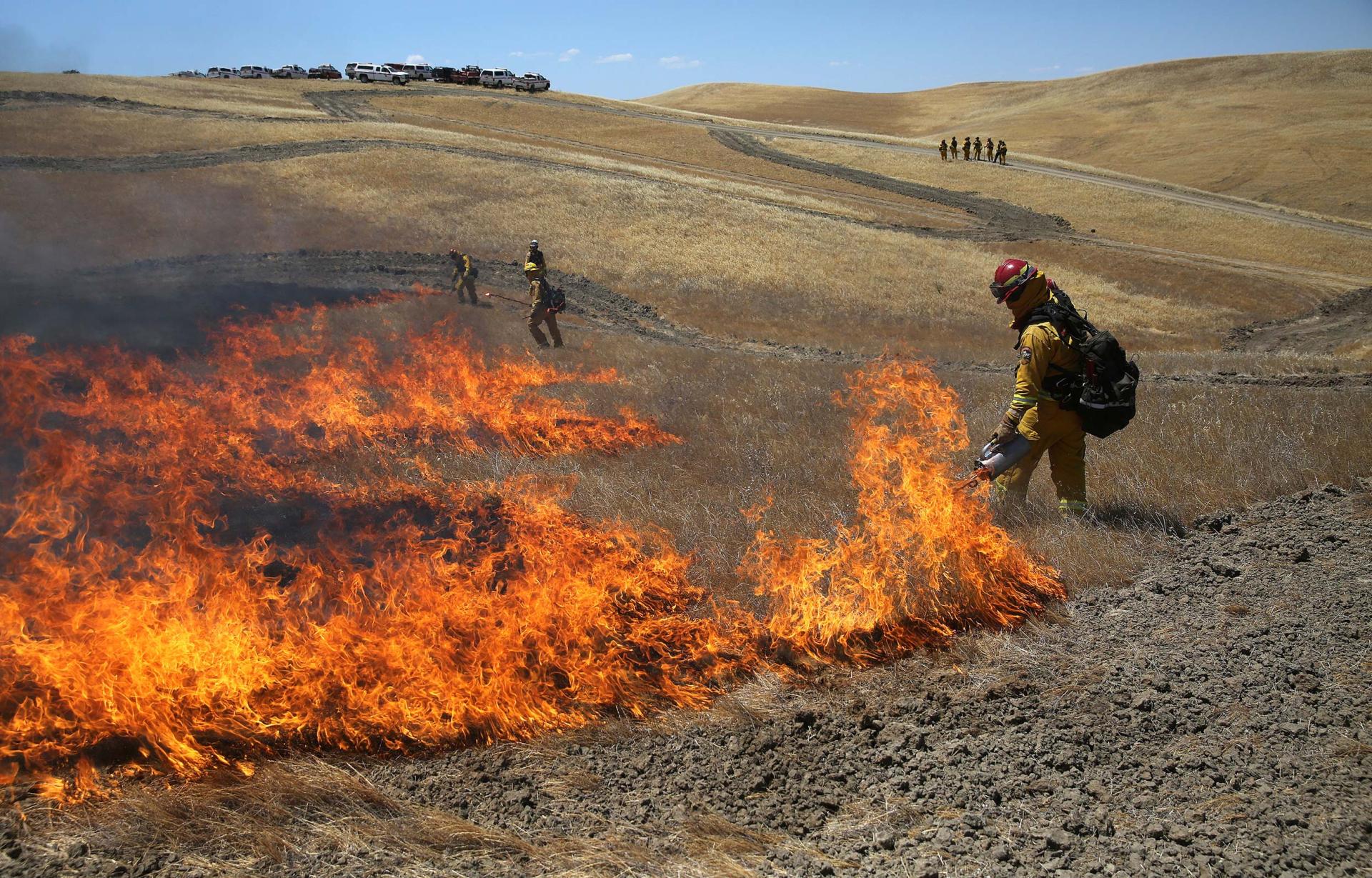Wildfire Management
Drought can be a contributing factor to wildfire. Dry, hot, and windy weather combined with dried out (and more flammable) vegetation can increase the probability of large-scale wildfires.
This map shows active large wildfires from the National Interagency Fire Center (NIFC) Incident Management Situation Reports, alongside current drought conditions from the U.S. Drought Monitor.
Note: This map only includes ongoing "large" wildland fires. It does not include prescribed burns, smaller fires, or other fires not included in NIFC's situation reports. View the latest situation report for more information.
The National Weather Service's Storm Prediction Center produces daily fire weather outlooks, which delineate areas of the continental U.S. where pre-existing fuel conditions, combined with forecast weather conditions, will result in a significant threat for the ignition and/or spread of wildfires. This map shows the 1-day fire weather outlook, alongside the most recent U.S. Drought Monitor.
The U.S. Air Quality Index (AQI) is designed to communicate whether air quality is healthy or unhealthy. This map displays the AQI at sensors across the U.S. alongside the current U.S. Drought Monitor, as of 10 a.m. Eastern.
Extreme weather events can interact or cascade—where one disaster event triggers or changes the probability of another event. For example, drought conditions can increase the probability of large-scale wildfires, and droughts are often accompanied by extreme heat. By including drought in multi-hazard planning, a community can consolidate its resources and develop coordinated responses before a disaster.
Learn MoreDuring drought conditions, fuels for wildfire, such as grasses and trees, can dry out and become more flammable. Drought can also increase the probability of ignition and the rate at which fire spreads. Temperature, soil moisture, humidity, wind speed, and fuel availability (vegetation) are all factors that interact to influence the frequency of large wildfires.
Learn MoreExtreme weather events can interact or cascade—where one disaster event triggers or changes the probability of another event. For example, drought conditions can increase the probability of large-scale wildfires, and droughts are often accompanied by extreme heat. By including drought in multi-hazard planning, a community can consolidate its resources and develop coordinated responses before a disaster.
Learn MoreDuring drought conditions, fuels for wildfire, such as grasses and trees, can dry out and become more flammable. Drought can also increase the probability of ignition and the rate at which fire spreads. Temperature, soil moisture, humidity, wind speed, and fuel availability (vegetation) are all factors that interact to influence the frequency of large wildfires.
Learn MoreDrought can cause significant human health outcomes that can challenge public health departments, emergency managers, and healthcare providers. Drought can lead to decreased water quantity and quality, increased incidence of illness or disease, increased mortality rates, and adverse mental health outcomes as livelihoods are challenged.
Learn MoreDuring drought conditions, fuels for wildfire, such as grasses and trees, can dry out and become more flammable. Drought can also increase the probability of ignition and the rate at which fire spreads. Temperature, soil moisture, humidity, wind speed, and fuel availability (vegetation) are all factors that interact to influence the frequency of large wildfires.
Learn MoreActive Large Wildfires
Large Fire
The National Interagency Coordination Center classifies "large" wildland fires as 100 acres or larger in timber and slash fuel models; 300 acres or larger in grass or brush fuel models; or when a Complex, Type 1, or Type 2 Incident Management Team is assigned.
U.S. Drought Monitor
D0 - Abnormally Dry
Abnormally Dry (D0) indicates a region that is going into or coming out of drought, according to the U.S. Drought Monitor. View typical impacts by state.
D1 – Moderate Drought
Moderate Drought (D1) is the first of four drought categories (D1–D4), according to the U.S. Drought Monitor. View typical impacts by state.
D2 – Severe Drought
Severe Drought (D2) is the second of four drought categories (D1–D4), according to the U.S. Drought Monitor. View typical impacts by state.
D3 – Extreme Drought
Extreme Drought (D3) is the third of four drought categories (D1–D4), according to the U.S. Drought Monitor. View typical impacts by state.
D4 – Exceptional Drought
Exceptional Drought (D4) is the most intense drought category, according to the U.S. Drought Monitor. View typical impacts by state.
Forecast Risk of Fire Weather
Elevated
Fire weather conditions are forecast to be elevated for temperature, wind, and relative humidity. Learn more about these designations.
Critical
Fire weather conditions are forecast to be critical for temperature, wind, and relative humidity. Learn more about these designations.
Extremely Critical
Fire weather conditions are forecast to be extremely critical for temperature, wind, and relative humidity. Learn more about these designations.
Isolated Dry Thunderstorms
The Storm Prediction Center has issued a forecast for isolated dry thunderstorms. This heightens the risk of fire ignition due to cloud-to-ground lightning, assuming a dry fuel bed. Learn more about these designations.
Scattered (Critical) Dry Thunderstorms
The Storm Prediction Center has issued a forecast for scattered (critical) dry thunderstorms. This heightens the risk of fire ignition due to cloud-to-ground lightning, assuming a dry fuel bed. Learn more about these designations.
U.S. Drought Monitor
D0 - Abnormally Dry
Abnormally Dry (D0) indicates a region that is going into or coming out of drought, according to the U.S. Drought Monitor. View typical impacts by state.
D1 – Moderate Drought
Moderate Drought (D1) is the first of four drought categories (D1–D4), according to the U.S. Drought Monitor. View typical impacts by state.
D2 – Severe Drought
Severe Drought (D2) is the second of four drought categories (D1–D4), according to the U.S. Drought Monitor. View typical impacts by state.
D3 – Extreme Drought
Extreme Drought (D3) is the third of four drought categories (D1–D4), according to the U.S. Drought Monitor. View typical impacts by state.
D4 – Exceptional Drought
Exceptional Drought (D4) is the most intense drought category, according to the U.S. Drought Monitor. View typical impacts by state.
Air Quality
AQI 0 to 50: Good
Air quality is satisfactory, and air pollution poses little or no risk. Learn more.
AQI 51 to 100: Moderate
Air quality is acceptable. However, there may be a risk for some people, particularly those who are unusually sensitive to air pollution. Learn more.
AQI 101 to 150: Unhealthy for Sensitive Groups
Members of sensitive groups may experience health effects. The general public is less likely to be affected. Learn more.
AQI 151 to 200: Unhealthy
Some members of the general public may experience health effects; members of sensitive groups may experience more serious health effects. Learn more.
AQI 201 to 300: Very Unhealthy
Health alert: The risk of health effects is increased for everyone. Learn more.
AQI >301: Hazardous
Health warning of emergency conditions: everyone is more likely to be affected. Learn more.
U.S. Drought Monitor
D0 - Abnormally Dry
Abnormally Dry (D0) indicates a region that is going into or coming out of drought, according to the U.S. Drought Monitor. View typical impacts by state.
D1 – Moderate Drought
Moderate Drought (D1) is the first of four drought categories (D1–D4), according to the U.S. Drought Monitor. View typical impacts by state.
D2 – Severe Drought
Severe Drought (D2) is the second of four drought categories (D1–D4), according to the U.S. Drought Monitor. View typical impacts by state.
D3 – Extreme Drought
Extreme Drought (D3) is the third of four drought categories (D1–D4), according to the U.S. Drought Monitor. View typical impacts by state.
D4 – Exceptional Drought
Exceptional Drought (D4) is the most intense drought category, according to the U.S. Drought Monitor. View typical impacts by state.
This map shows active large wildfires from the National Interagency Fire Center (NIFC) Incident Management Situation Reports, alongside current drought conditions from the U.S. Drought Monitor.
Note: This map only includes ongoing "large" wildland fires. It does not include prescribed burns, smaller fires, or other fires not included in NIFC's situation reports. View the latest situation report for more information.
The National Weather Service's Storm Prediction Center produces daily fire weather outlooks, which delineate areas of the continental U.S. where pre-existing fuel conditions, combined with forecast weather conditions, will result in a significant threat for the ignition and/or spread of wildfires. This map shows the 1-day fire weather outlook, alongside the most recent U.S. Drought Monitor.
The U.S. Air Quality Index (AQI) is designed to communicate whether air quality is healthy or unhealthy. This map displays the AQI at sensors across the U.S. alongside the current U.S. Drought Monitor, as of 10 a.m. Eastern.
NIFC updates active large fire data daily or weekly, depending on the nation's National Preparedness Level. Learn more.
This map is updated daily with data from the National Weather Service's Storm Prediction Center. View more fire weather outlooks.
On Drought.gov, Air Quality Index maps are updated daily at 10 a.m. Eastern. View hourly air quality information from AirNow.
Extreme weather events can interact or cascade—where one disaster event triggers or changes the probability of another event. For example, drought conditions can increase the probability of large-scale wildfires, and droughts are often accompanied by extreme heat. By including drought in multi-hazard planning, a community can consolidate its resources and develop coordinated responses before a disaster.
Learn MoreDuring drought conditions, fuels for wildfire, such as grasses and trees, can dry out and become more flammable. Drought can also increase the probability of ignition and the rate at which fire spreads. Temperature, soil moisture, humidity, wind speed, and fuel availability (vegetation) are all factors that interact to influence the frequency of large wildfires.
Learn MoreExtreme weather events can interact or cascade—where one disaster event triggers or changes the probability of another event. For example, drought conditions can increase the probability of large-scale wildfires, and droughts are often accompanied by extreme heat. By including drought in multi-hazard planning, a community can consolidate its resources and develop coordinated responses before a disaster.
Learn MoreDuring drought conditions, fuels for wildfire, such as grasses and trees, can dry out and become more flammable. Drought can also increase the probability of ignition and the rate at which fire spreads. Temperature, soil moisture, humidity, wind speed, and fuel availability (vegetation) are all factors that interact to influence the frequency of large wildfires.
Learn MoreDrought can cause significant human health outcomes that can challenge public health departments, emergency managers, and healthcare providers. Drought can lead to decreased water quantity and quality, increased incidence of illness or disease, increased mortality rates, and adverse mental health outcomes as livelihoods are challenged.
Learn MoreDuring drought conditions, fuels for wildfire, such as grasses and trees, can dry out and become more flammable. Drought can also increase the probability of ignition and the rate at which fire spreads. Temperature, soil moisture, humidity, wind speed, and fuel availability (vegetation) are all factors that interact to influence the frequency of large wildfires.
Learn MoreDrought and Wildfire Interactions
The relationship between drought and fire is complex. The timing, intensity, and frequency of drought events have divergent impacts on fuel flammability and fire behavior. Rapidly drying abundant fuels in forest understories and grasslands after a wet spring can feed larger fires. Prolonged drought can limit fire occurrence as the availability of fuels (e.g., grasses) is reduced due to lack of precipitation.
Reducing the Potential for Wildfires
Wildfire potential can be reduced in some forests in the West and South by thinning trees, prescribed burning, and letting fires that will not affect people burn. There are also actions that individual homeowners can take to create a defensible space, an area around a building/property in which vegetation, debris, and other types of combustible fuels have been treated, cleared, or reduced to slow the spread of fire to and from the building.
Cascading Impacts of Drought and Wildfire
Drought can impact drinking water supply, agriculture, and human health. When wildfire hits in drought-stricken areas, watersheds and reservoirs can be further impacted by ash and debris flows, water treatment facilities may shut down with damage or loss of power, crops can be destroyed, and smoke can affect animal and human health.
Drought in a Changing Climate
Drought, combined with warming temperatures, can result in decreased snowpack and streamflow, increased evaporative demand, dry soils, and large-scale tree deaths, which results in increased potential for large wildfires.
Drought Impacts on Wildfire Management
Wildfire—a critical ecosystem process—is a global phenomenon with natural (lightning) and human-caused sources of ignition. During drought conditions, fuels for wildfire, such as grasses and trees, can dry out and become more flammable. Drought can also increase the probability of ignition and the rate at which fire spreads.
Drought can be intensified by unusually warm temperatures. When combined with very low precipitation and snowpack, extreme heat can lead to decreased streamflow, dry soils, and large-scale tree deaths. These conditions create increased potential for extreme wildfires that spread rapidly, burn with more severity, and are costly to suppress.
The potential for wildfires can be reduced by reducing stand density (thinning), using prescribed burning, and letting some fires burn if they will not affect people. Frequent prescribed burning in fire-prone and fire-dependent (forests that require fire to maintain structure and function) southern forests has been a socially accepted practice for decades, illustrating how the negative impacts of wildfire can be reduced. In some instances, drought can actually reduce the potential for wildfires by reducing the amount of vegetation that is available to burn.
Even with these existing practices to reduce damaging wildfires and maintain ecosystem health, large and extreme burning wildfires continue to challenge fire suppression efforts and budgets. Projected warmer temperatures and a possible increase in the frequency of drought in some regions may require rethinking historical approaches to fire management. If drought-caused wildfire activity increases in the wildland-urban interface, suppression costs will also increase, potentially altering perceptions of management and risk in fire-prone human communities. Therefore, fire professionals have a need for drought information for fire behavior forecasts and long-term fuel management planning.
In an effort to provide that information, the NIDIS Drought and Wildland Fire Nexus (NDAWN) strategy was developed to improve the use of drought information by wildland fire management, air quality managers, fire meteorologists, and fire behavior analysts, and to enhance and develop products to improve firefighter safety, public health and safety, fuel treatment effectiveness pre- and post-fire, and meet overall land management objectives. Broader planning and preparedness topics, including preventing economic and infrastructure losses, are addressed in NDAWN as well.
Drought Early Warning for the Wildfire Management Sector
Wildland fire managers, fire meteorologists, and fire behavior analysts have an increasing need for drought information to be incorporated into fire-related forecasts and long-term fuel management planning. Drought early warning information is essential to improve firefighter and public health safety, to increase fuel treatment effectiveness pre- and post-fire, and to better understand post-fire recovery. The resources below are organized by the key components of a drought early warning system: (1) drought observation and monitoring; (2) drought planning and preparedness; (3) prediction and forecasting of drought; (4) communication and outreach to the public and affected sectors; and (5) interdisciplinary and applied research on topics of concern to drought-affected sectors.
Planning & Preparedness

Communication & Outreach

Interdisciplinary Research & Applications





